In our latest collaborative article, 17 members contemplate ‘family’.
Aude Hérail Jäger
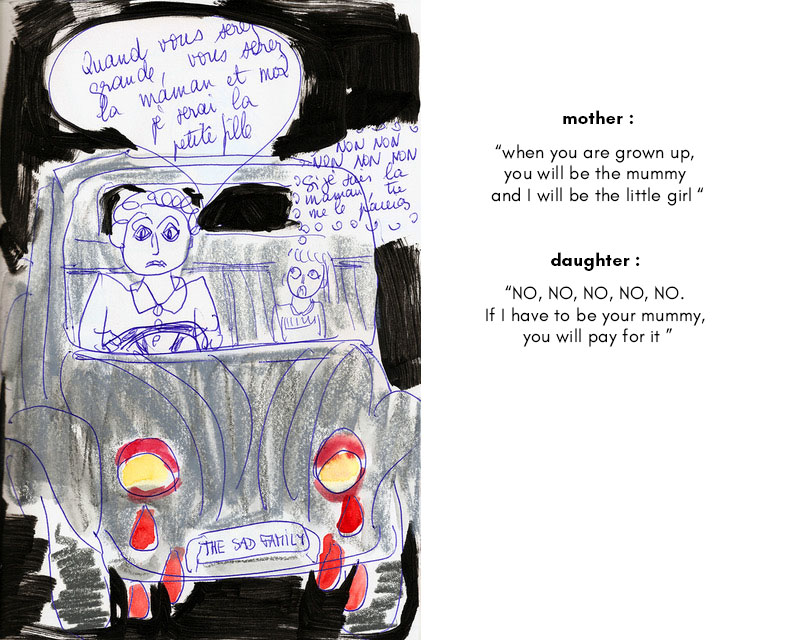
and this did not materialise
for one, once grown-up, the girl left her country
with hindsight,
at that moment, mother must have felt alone or scared and turned to her daughter for comfort
daughter was very little, in need of her parents’ nurturing to develop into adulthood
so, a woman needed solace from her beloved daughter – fair enough;
a girl got angry with her beloved mother’s one-sided imposition into her future – fair enough
end
afterthought:
learning to read and articulate one’s feelings and states of mind would save a lot of energy
Lisa Traxler
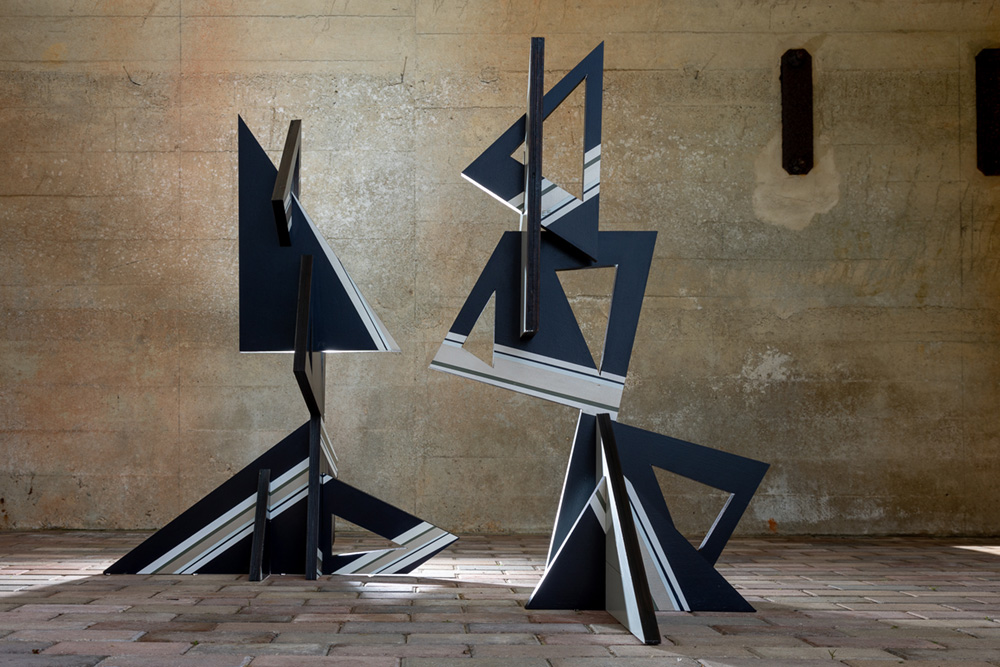
One of my favourite sculptural works is Barbara Hepworth’s ‘The Family of Man’ a group of nine bronze totemic sculptures each representing a stage of human life. This suggestion of each abstract component alluding to a human figure stayed with me long after viewing them at The New Art Centre, Roche Court in Wiltshire. An echo from this is evident in these two ‘Infants’ sculptures, offspring of the fully grown ‘Shape Shifters’ I created for my exhibition at Southampton this year. Although not directly figurative the human form comes to mind and the interaction of one piece of work in proximity to another, the shape between adding tension. They can be viewed singularly but have more impact as a small group or part of a family.
Peter Clossick
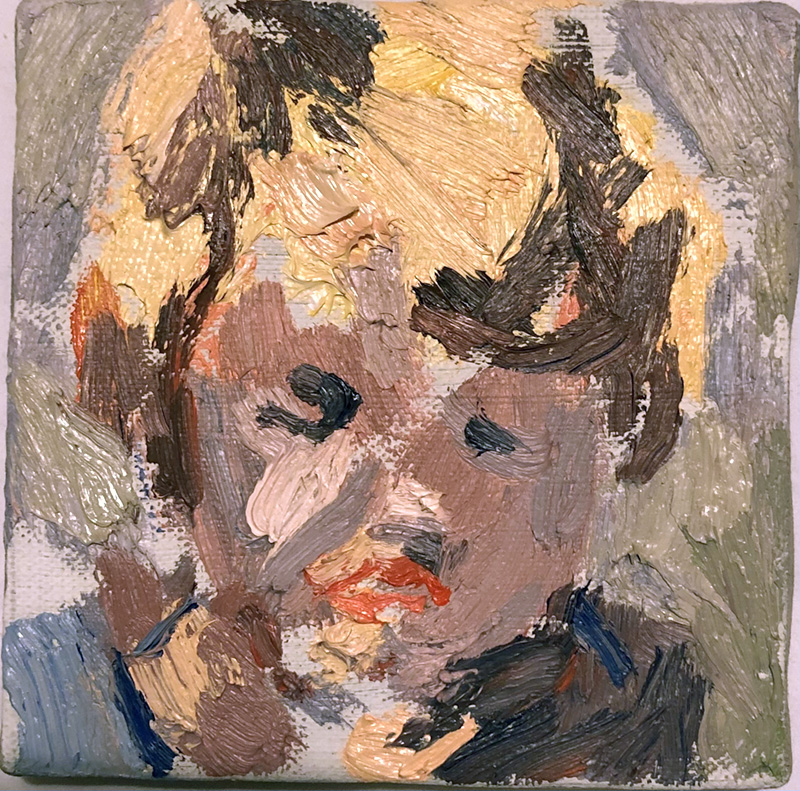
Family is from the Latin word Familia and having one of your own is about you growing up, from a youth to an adult. How can you describe the love you have for your children, and children’s children, there is no measure.
We are all part of an extended family of artists within the art world, one’s circle of friends, coworkers, teammates, community and organisations. All competing against each other, climbing our individual ladders, within the individualistic capitalist system that we are part of where success lies buried in the garden of failure. The socialist William Morris believed that art could change society, but in the end, realised he had spent his life “ministering to the swinish luxury of the rich”.
I hope that is not our family’s fate and that our love continues to rule what we do.
Suzan Swale

Family is very important to Robert and me. We have a family house in Greece and usually travel there every summer. For 5 years we drove there, through France, Switzerland, Italy and then put the car on the ferry from Ancona to Patras; then drove across mainland Greece and got a ferry to the island of Páros. Robert would fly back to London to work in the office. Recently we transferred the house to our children. Sunshine and Sacha.
This year I intend to fly there with Sacha and Dan. Here is a very old Christmas card. A picture of our family.
Michael Phillipson
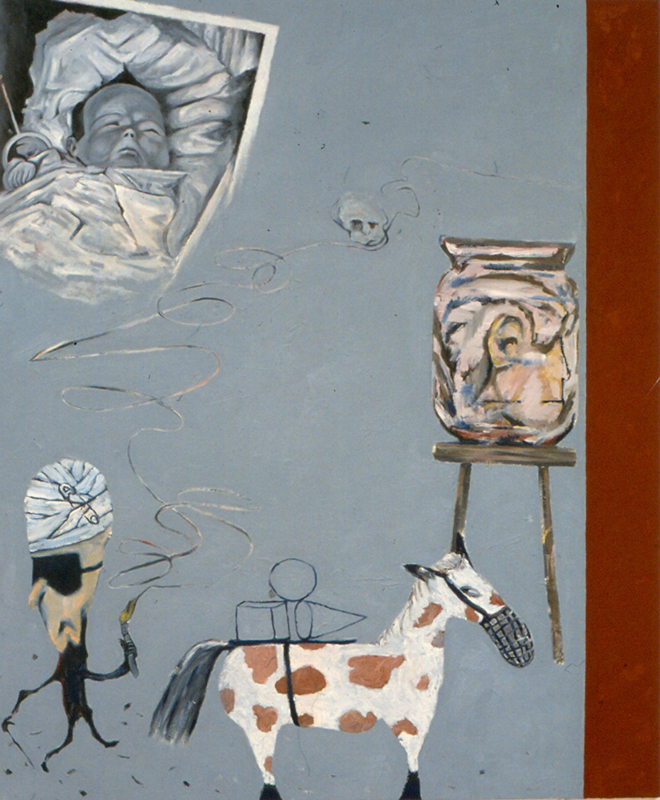
What’s inner name? What’s buried within the family-(sur)name-trails stretching backwards to infinity, lost to most of us after three or four generations…the and-and-and- of the dna-dna-dna accidental cocktails that, unpicturable but mappable, nevertheless fix us as the one-offs (the pluperfect strangest mix-ups that we are) whose names point vaguely back toward and hint at our Ur-, our forever lost origins (urigins?), composites of untraceable languagings-journeyings-haltings-doings across the long-gone-used-to-be? For instance, by the mid-19th century, Phillipson(Greek-horse-lover’s son)+de Rome(via Italy-French-Huguenot-to-London)+Sykes(sik – a Norse-Yorkshire ditch)+Garside(a Lancastrian hilly plot) had, coming to temporary rest across Manchester, bumped into each other and, little by little, chanced to stick together for the time being. But, saulting ever further and further back (daring saltimbanques that we are and singing along as we go in perfect pitch and time to Pharoah Sanders’ delightfully apposite ‘Our Roots Began in Africa’), we all too soon find and lose ourselves in the Central Rift Valley’s Olduvai Gorge. Right there our furthest (but still, hopefully, nearest and dearest) were already itching to drift off and away Eastwards and Northwards in the hope that they (and thus we) might eventually just see, along with Tiresias (bless him poor deluded lad), around the next corner, a completely different future.…
David Redfern

The precious family tree of which all life is part.
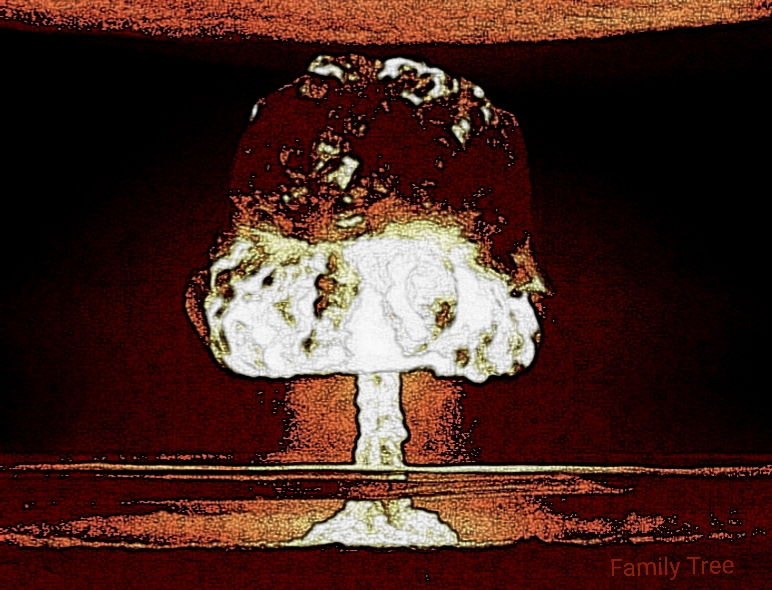
Chris Horner
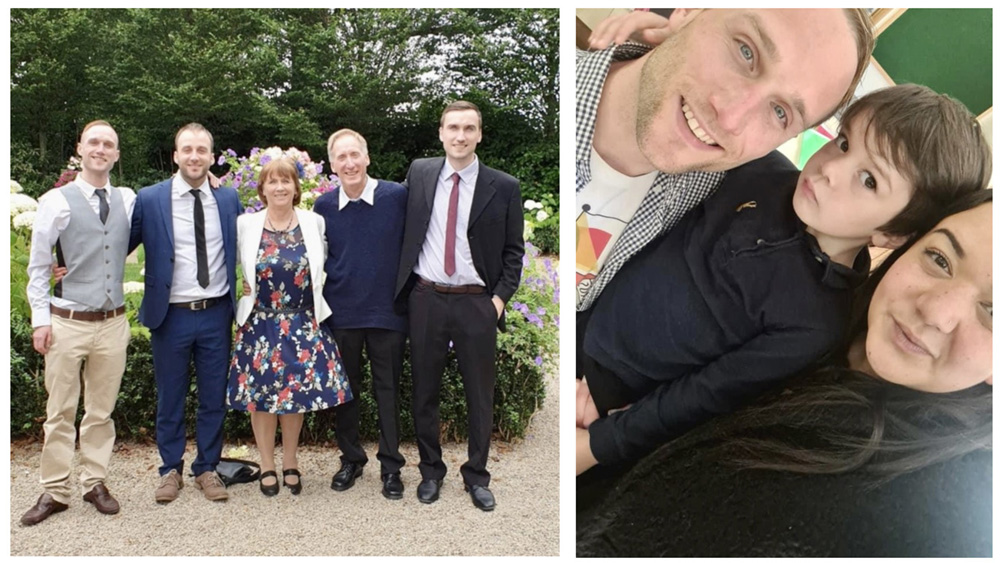
“Family”
I always think how lucky I am to have a family. The support and love that me and my family give one another is inseparable! And the confidence we try to give each other is something I always think about. Life can be hard, but when you have an arm over your shoulder, everything then seems a little easier. We are a unit! Each one of us acts as a pillar for each other, to offer strength, and to stop the possibility of falling and going through the cracks of life. I love my family! I would be lost without them!
Micheál O’Connell / MOCKSIM
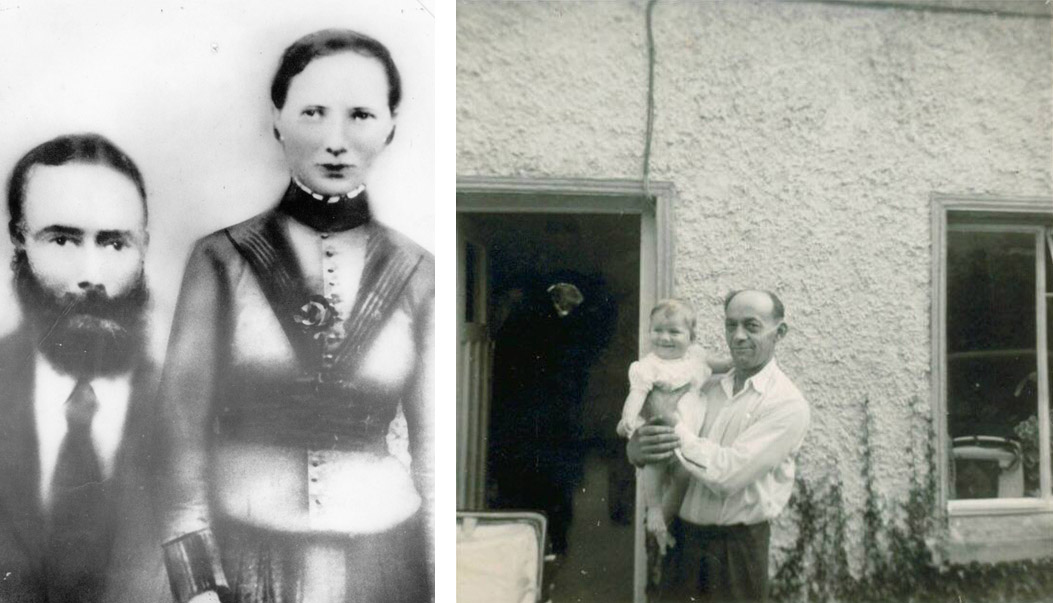
A nineteenth century photo-montage of my great great grandfather Taidhg O’Connor ‘The Gaileach’ with his daughter Catherine.
He was born I believe in Ballydesmond on the border between Co. Cork and Co. Kerry, Ireland. The story told (by our beloved maternal grandmother, ‘Nanna’) was that, as a youth in the post-famine period, he had been involved in some kind of anti-eviction activity, was caught and sentenced to death by the British, but given the option to join the army instead, which he naturally took.
He fought in Crimea (and possibly, according to some, even took part in the Charge of the Light Brigade). Taidhg lost a leg but survived – thanks to Florence Nightingale or Mary Seacole no doubt – was decorated and in compensation (British irony alert) given a cottage in Gneevguilla, Co. Kerry. This was considered something special: the first non-thatched home there. He had children including Catherine pictured and my great grandfather Jeremiah who is buried in the village along with more recent ancestors and a brother I never met. Taidhg was a joker apparently and would ask local children to help remove his boot knowing that the whole wooden leg would detach.
My mother grew up in the same cottage and we were often, as children, taken to visit our grandparents there. I remember the astonishing thickness of the walls. The other pic, the snapshot (above, right) is of me outside the house being held by my grandfather (and Taidhg’s grandson) Mikey O’Connor. The rural village felt exotic compared to Cork City. Our grandparents were generous, easygoing, entertaining and great storytellers.
Later the house was passed on but it still stands, odd-shaped (because the old building is within it) and somewhat bungalowfied: See here https://goo.gl/maps/TYb2WuSQbNJ2.
So this is about, in no particular order, photography, politics, pranksterism, history, housing and heroics.
Amanda Loomes
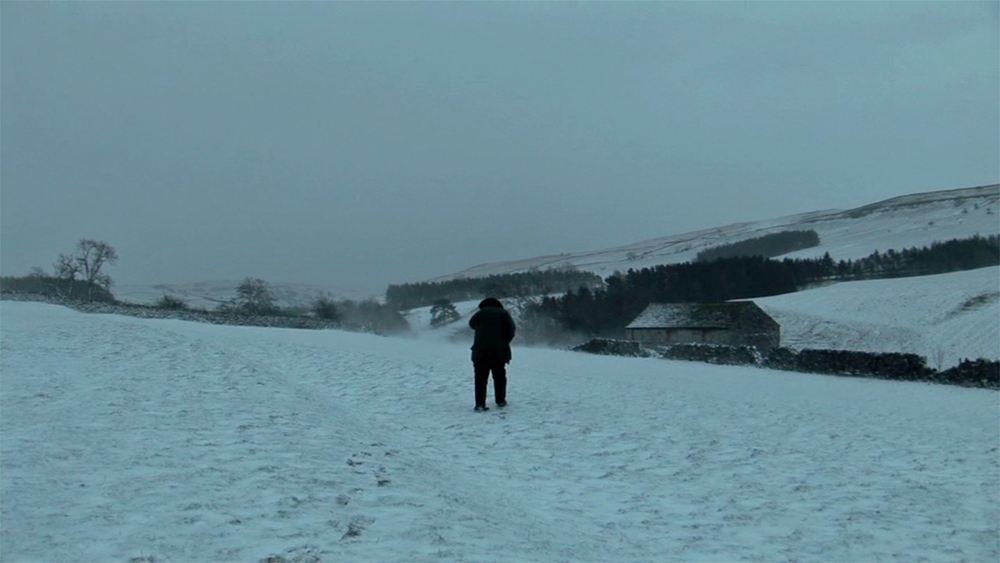
A bridge between past, present and future possibilities. Nature and nurture built in.
This image is a video still from the film Closure that I made for The London Group exhibition Bridge. I made the film with my Dad during his final lambing season.
Susan Wilson

I have children whom I painted all through their childhood. They were tolerant and enjoyed the tasks I set them, mostly this meant keeping still. I exhibited these paintings and won recognition for them in various papers, The Guardian, Artists Newsletter, Art Forum and even the Spectator. I would pay my son in Pokemon cards for two hours sitting. In 1993, on being awarded an Abbey Award, I insisted on them coming with me to the British School in Rome. They were two and five years old. Alternative accommodation in an animal house on a mountain ridge at San Vincenzo al Volturno was arranged. This house belonged to Professor Amanda Claridge who took us there driving out from the BSR along the Via Appia Antica. Amazing!
In our Fiat Uno, with all our gear, and my husband, driving over the Gran Col St Bernard and along the Italian motorways was formative for the children. It took them into the wild – wolves, bears, snakes, scorpions, crickets and lizards live well in the Abruzzi National Park. I was researching my father’s experience at the battles for Cassino. He refused to fight and was a medical orderly. San Vin is on the old Gustav Line, a drive over a mountain range from Cassino. But with my children, it was a rich, wonderful time. I had help, but I got a huge amount done and was invited back the next year to exhibit in the Commune at San Vincenzo. The BSR had a huge archaeological dig way below the house on the Volturno River.
Paul Bonomini
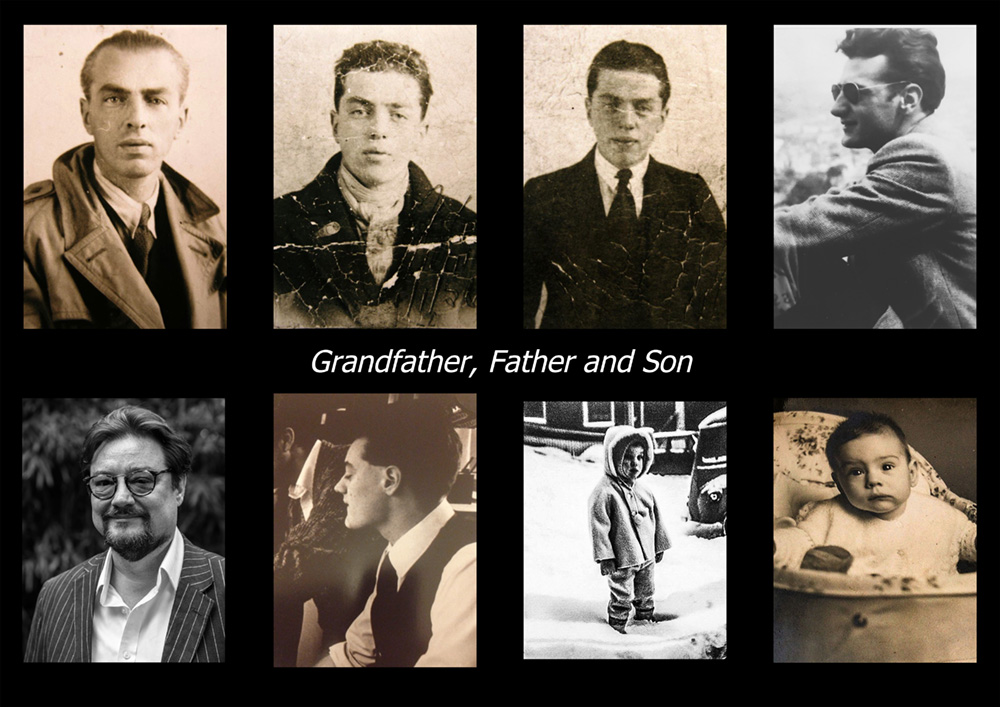
Grandfather, father and son.
I am glad to say this London Group Collaborative article has prompted me to begin the task of putting together my family tree. I have discovered it to be a daunting task, especially when so little is known about my family history, and there are so few surviving relatives. On my father’s side we are Italian, French and Scottish, and my mother’s side German and English – ish. Sadly there are very few surviving photographs. I’ll begin with grandfather, father and son.
Victoria Bartlett
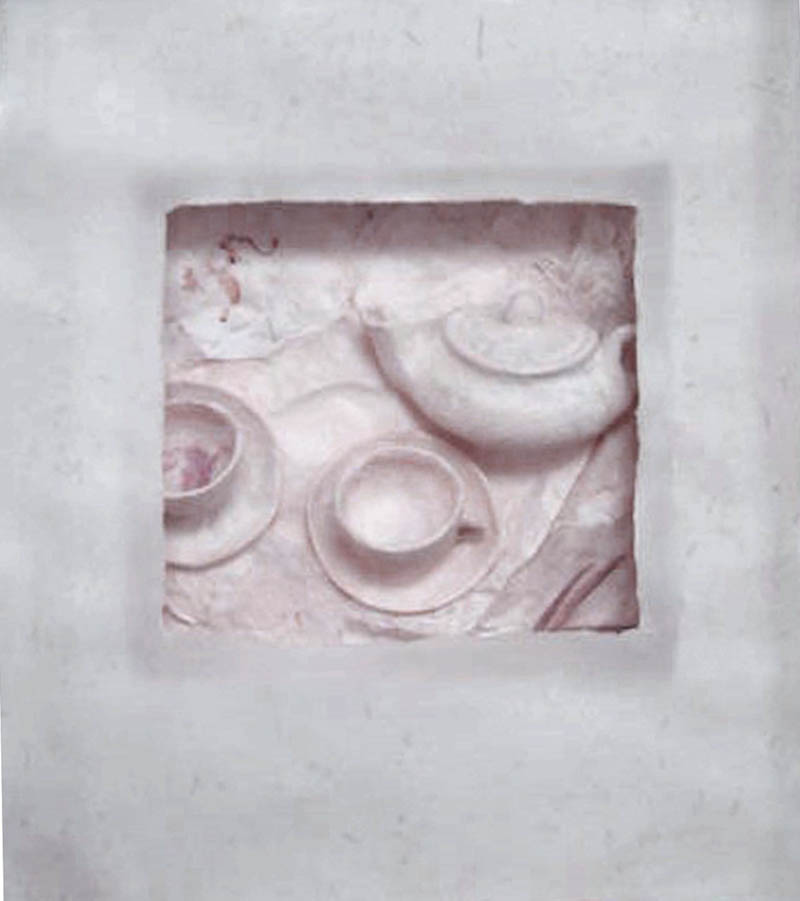
A picnic tea is a family affair. Here is a memory in white paper, reduced in size but tangible. Some dried plants are embedded in the paper and the tea leaves in the cup may foretell the future?
The other family is of shapes, voids and volumes which make the form.
Martin Darbyshire
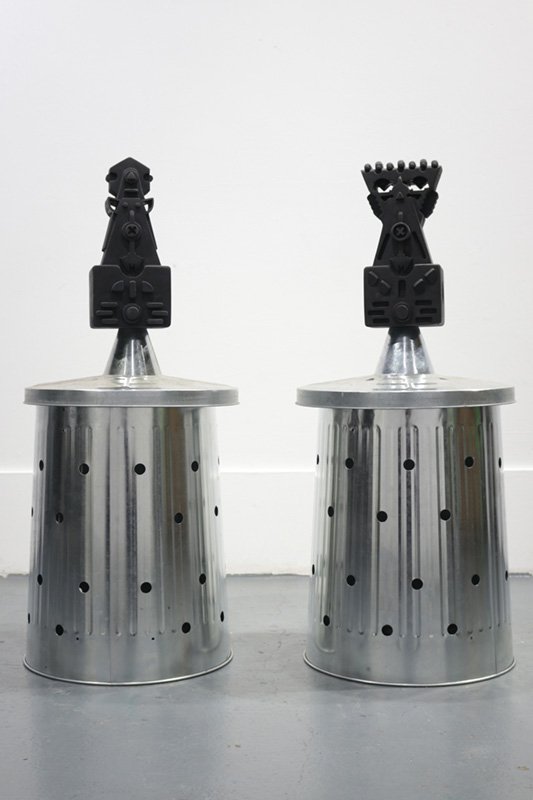
The sculpture Progenitor contemplates the ambivalent relationship between children and parents. Taking the title from Samuel Beckett’s bleak account of the dysfunctional nature of families in Endgame, and the absurdity across Beckett’s oeuvre, the work was a cathartic response to my father’s death.
Talking about the effect of his father’s death on him, Beckett said that rather than freeing himself from the relationship, he “only walked the fields and climbed the ditches after him” – something which I can wholeheartedly relate to.
Sumi Perera
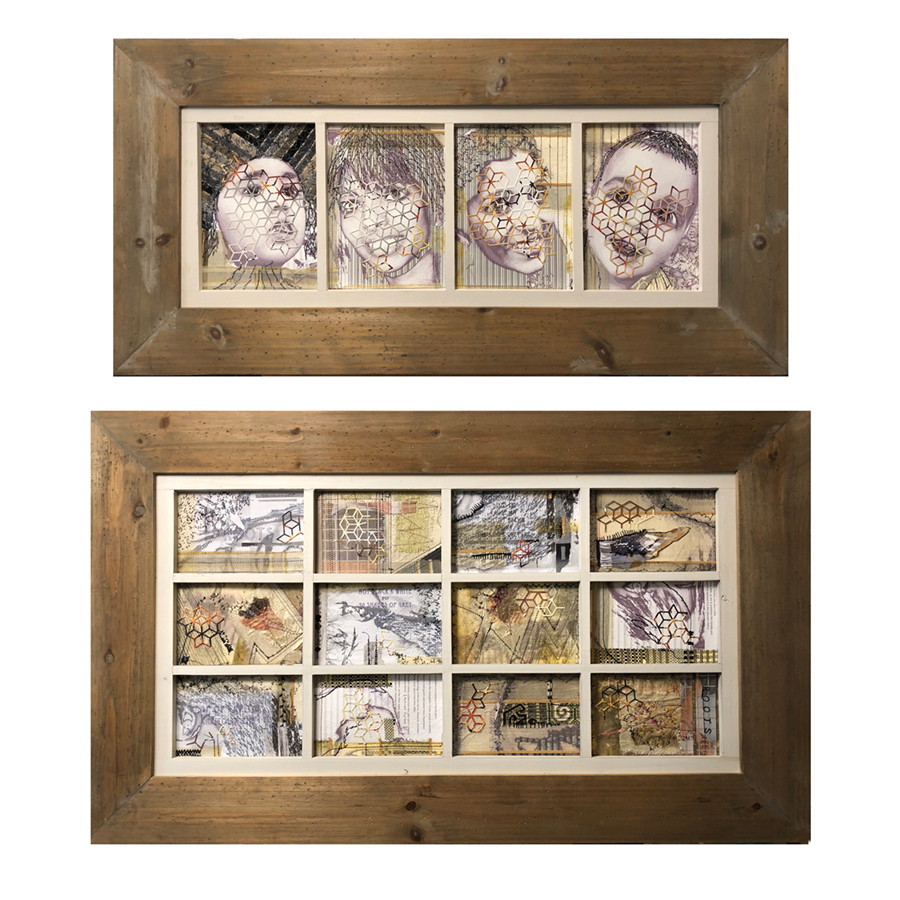
ROOTS-It’s Not Black & White but 50 Shades of Grey & Brown
A series of ongoing works that reflect on the multicultural aspects of my family, features embroidered portraits of myself, kids & biracial grandkids deconstructed+reconstructed, layered with fabric (old+new) collected since childhood from many countries.
It signifies the colonial history of Sri Lanka (my native country of birth with the Portuguese, Dutch & British occupation since 1505).
Theories of imperialism & Colonialism form a palimpsest over the fragmented faces.
It was shown at:
-IN PLAIN SIGHT at Thelma Hulbert Gallery, Devon (’21).
-CONVERSATIONS at St Barbe Museum & Art Gallery, Hampshire (’22).
-BRITISH TEXTILE BIENNIAL: Stitch a Story at Blackburn Cathedral (’22).
Julie Held
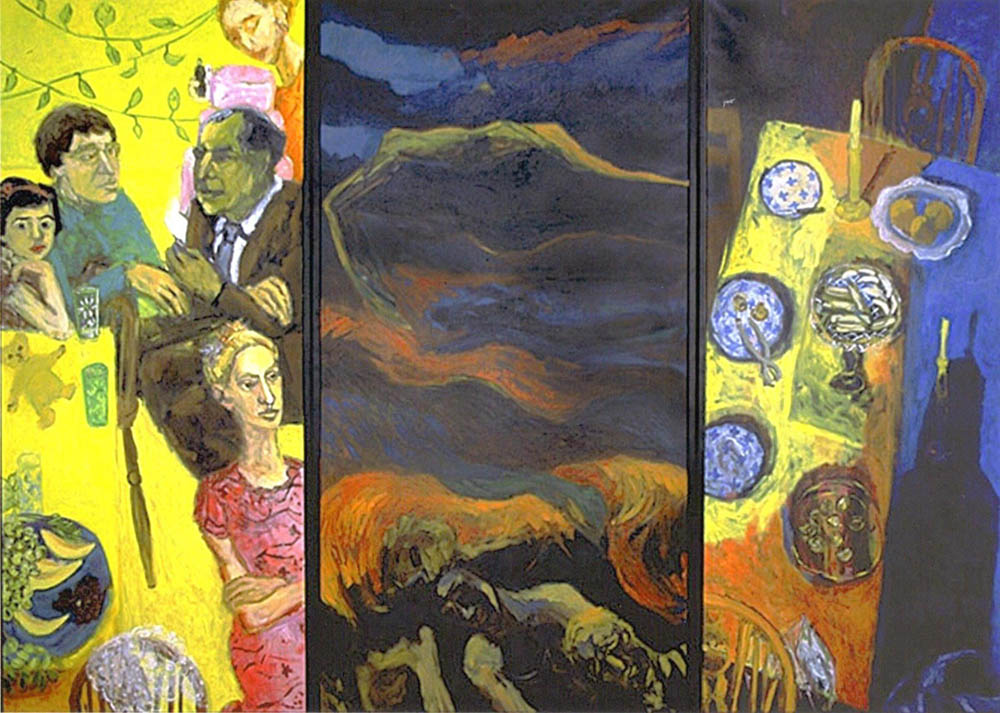
The triptych is based on The Rhyme of The Ancient Mariner : a poem evoking so much : a tale told , guilt , redemption and wandering included. I transposed the tale of my family onto it as content / subject in the right and left panel. The central one is an exploration of the death scene in the poem. It’s part of a series I call “Mariner “.
The Three Sisters – After Chekhov is a painting of all that’s left of my family , our brother having died three years ago. I celebrate us.
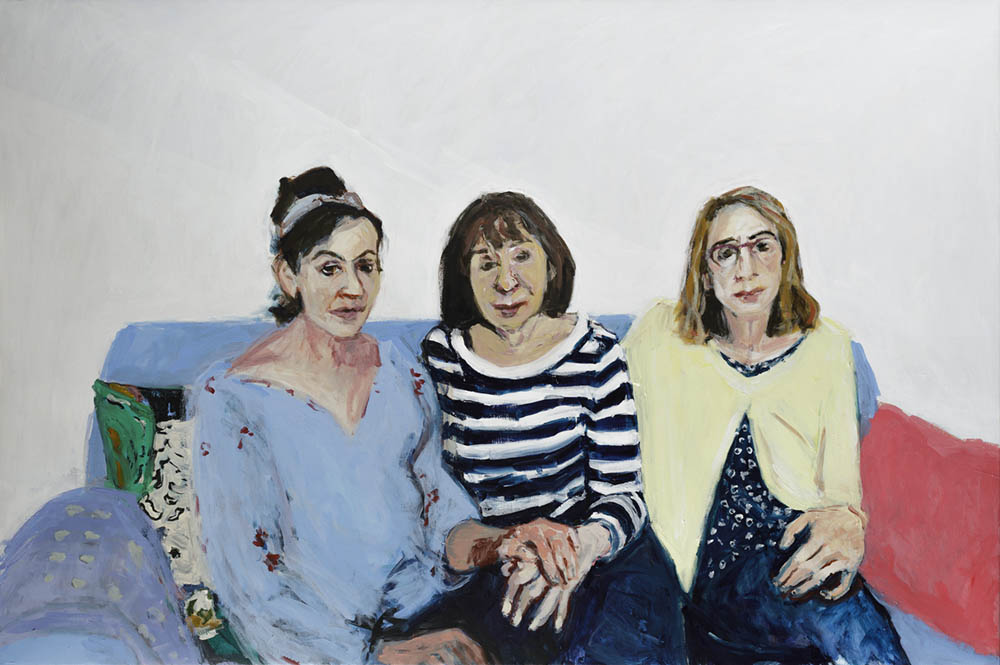
Almuth Tebbenhoff
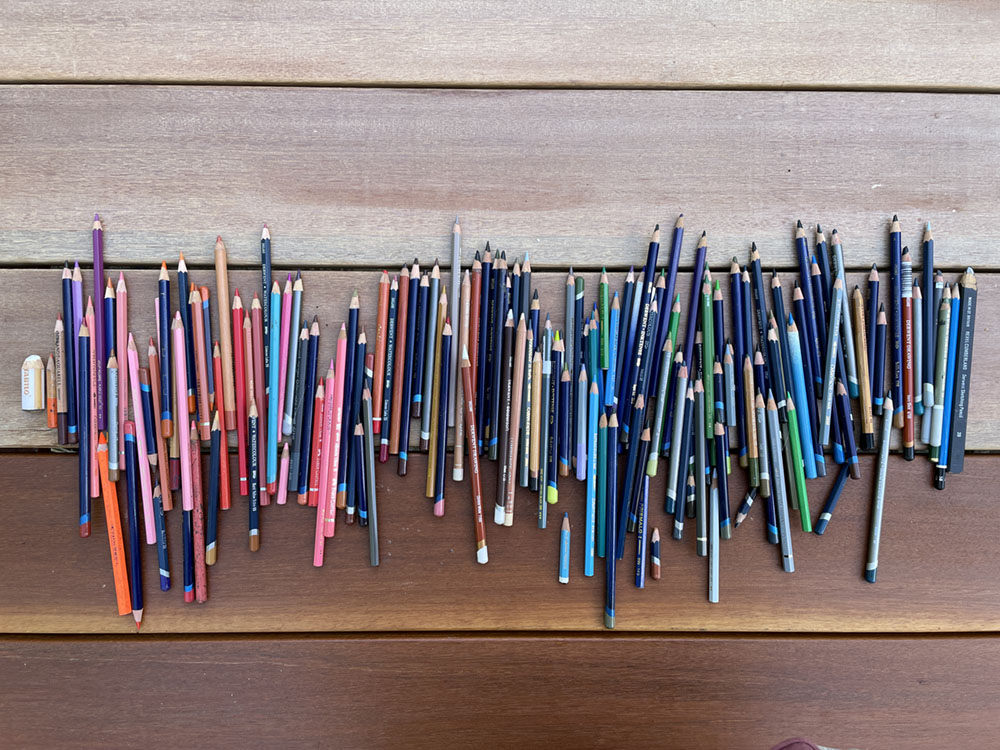
Family is a great subject and applies to everything that can be grouped together. Since I left my family in Germany a very long time ago when I was a 17 year-old excited, confused, hungry-for-culture teenager, I’ve been gathering all sorts of families around me to make up for what I abandoned. Friends, artists, art, music, cats, plants – all with lots of subgroups. I need my families to help me function in the world and the umbrella underneath we all huddle is very large.
For instance, over the last year I have gathered a family of watercolour pencils. I started to draw in great detail with fine lines in all sorts of colour harmonies (another family: of colours) which I group into warm and cold, dark and light colours. I am now the proud owner of boxes of beautiful coloured pencils and then a range of pencil sharpeners. I feel that the members of my pencil family support me very nicely in my drawings, they don’t judge me or refuse to obey my guidance, not at all, they press ahead with whatever odd request I ask of them with just the right amount of response. Being a reasonable person I don’t even blame them when they produce something horrible, and they do.
I miss my German family, my sisters, nieces, great nephews and great nieces. I could howl like a dog at the moon when I leave Germany, until I am home in England again. Here I have a fabulous, almost completely made up family with hand-picked specimens of all shapes and forms, ages, ways of thinking and being. I think families are about loving that little bit extra because you just do even while you could wring someone’s neck who you shared parents with.
We now have to expand all our ideas of what families are to include strangers. The world is changing and we need to be open to change too. One big family…
